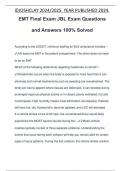©JOSHCLAY 2024/2025. YEAR PUBLISHED 2024.
EMT Final Exam JBL Exam Questions
and Answers 100% Solved
According to the USDOT, minimum staffing for BLS ambulance includes: -
✔✔At least one EMT in the patient compartment. The driver does not need
to be an EMT
Which of the following statements regarding heatstroke is correct? -
✔✔Heatsrtoke occurs when the body is exposed to more heat than it can
eliminate and normal mechanisms such as sweating are overwhelmed. The
temp can rise to appoint where tissues are destroyed. It can develop during
prolonged vigorous physical activity or in closed, poorly ventilated, hot and
humid space. High humidity impairs heat elimination via sweating. Patients
will have hot, dry, flushed skin, become agitated, and LOC will decrease
If a vehicle strikes a tree at 60 mph, the unrestrained driver would likely
experience the MOST severe injuries during the: - ✔✔Motor-vehicle
crashes typically consist of three separate collisions. Understanding the
events that occur during each collision will help you remain alert for certain
types of injury patterns. During the first collision, the vehicle strikes another
,©JOSHCLAY 2024/2025. YEAR PUBLISHED 2024.
object. Damage to the car is perhaps the most dramatic part of the
collision, but it does not directly affect patient care. It does, however,
provide information about the severity of the collision; thus, it has an
indirect effect on patient care. During the second collision, the passenger
collides with the interior of the vehicle. Just like the obvious damage to the
exterior of the car, the injuries that result are often dramatic and usually
apparent during your primary assessment. During the third collision, the
occupant's internal organs collide with the solid structures of the body.
Although the injuries that occur during the third collision may not be as
obvious as those that occur during the second collision, they are often the
most life-threatening.
A 22-year-old man had a strong acid chemical splashed into both of his
eyes. He is conscious and alert, is experiencing intense pain, and states
that he is wearing contact lenses. Treatment should include: - ✔✔As a
general rule, contact lenses should be left in place. Chemical eye burns are
an exception to this rule. If left in place, the chemical could get behind the
contact lens and continue to cause injury. Therefore, you should remove
the contact lenses and immediately irrigate the eyes with sterile saline or
water. If needed, continue to irrigate the eyes throughout transport.
,©JOSHCLAY 2024/2025. YEAR PUBLISHED 2024.
A 22-year-old male has a shard of glass impaled in his cheek. You look
inside his mouth and see minor bleeding. The patient is conscious and alert
with adequate breathing. You should: - ✔✔It remains true that you should
remove an impaled object if it compromises the airway or impedes your
ability to manage the airway. However, neither is the case with this patient
because he has an adequate airway. He is conscious and alert and has
only minor bleeding in his mouth. The safest approach, and most practical
given the situation, would be to carefully stabilize the shard of glass in
place; consider wrapping the exposed glass with gauze to protect yourself
from getting cut. Since the patient is conscious and alert and has only
minor oral bleeding, it would not be unreasonable to hand him the suction
catheter and allow him to use it as needed. Be sure to instruct the patient to
use the suction and not to swallow any blood. Keep in mind that if you
attempt to remove the shard of glass, you risk cutting yourself and causing
further injury to the patient.
When an error occurs while using the AED, it is MOST often the result of: -
✔✔AEDs are highly sensitive and specific in recognizing shockable
rhythms (eg, V-Fib, pulseless V-Tach); this means that they are highly
reliable. It would be extremely rare for the AED to recommend a shock
when one is not indicated or fail to recommend a shock when one is
, ©JOSHCLAY 2024/2025. YEAR PUBLISHED 2024.
indicated. When an error does occur, it is usually the operator's fault. The
most common error is not having a charged battery. To avoid this problem,
many AEDs are equipped with an alarm that warns the operator if the
battery is not fully charged. Some of the older AEDs, however, are not
equipped with this feature. Therefore, it is important to check the AED daily,
exercise the battery as often as the manufacturer recommends, and always
have a spare, fully charged battery on hand.
Prior to your arrival, a woman experiencing an asthma attack took two puffs
from her prescribed inhaler without relief. After administering supplemental
oxygen, you should: - ✔✔Before assisting a patient with any medication
other than oxygen, the EMT must ensure that the medication is prescribed
to the patient and then obtain authorization from medical control. In this
case, the physician probably will allow you to help the patient take one
more puff from her inhaler. Generally, up to three puffs from an inhaler are
delivered in the field. It is important for you to ask the patient how many
puffs were taken from the inhaler before you arrived. The EMT must correct
any airway and/or breathing problems as quickly as possible. After doing
so, a secondary assessment can be performed.
Upon discovering an open chest wound, you should: - ✔✔Upon discovering
an open chest wound (ie, sucking chest wound), you must take immediate




